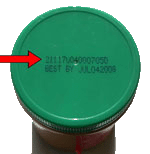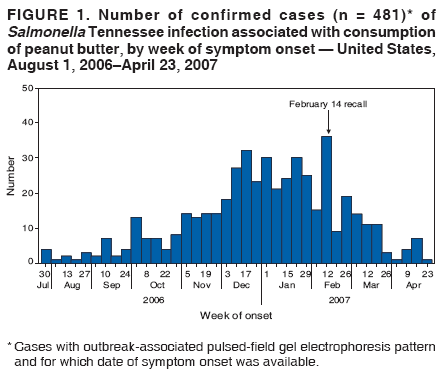Investigations on Salmonella Outbreak
| Early Stage of Outbreak | | Investigations | | Outbreak Summary | | Aftermath |
CDC and state health department officials noticed a substantial increase in the reported incidence of isolates of Salmonella serotype Tennessee in November 2006.
PulseNet officials noted a substantial increase in the number of isolates of the outbreak strain of Salmonella serotype Tennessee.
- During 2005 and most of 2006, these isolates were reported to PulseNet at a rate of one to five per month, however in October 2006, 30 isolates were reported.
- Pulsed-field gel electrophoresis (PFGE) patterns of the Salmonella Tennessee strains isolated from patients were uploaded from state health department databases to CDC databases. Three closely related patterns were found to be associated with this outbreak.
The initial investigation showed that cases were not clustered geographically.
From November - December 2006, state and local officials from OutbreakNet conducted patient interviews.
- Interviews of 26 patients in January 2007 using a standard food-consumption survey instrument of approximately 200 items indicated that 48% of the patients had eaten turkey (excluding delicatessen-sliced turkey) and 85% had eaten peanut butter during the week prior to illness onset
- This is a much higher proportion than would be expected from food-consumption surveys of the U.S. population
- Results of the interviews did not determine a common food exposure.
A multistate case-control study (with 65 patients and 124 controls in order to identify the food item associated with illness) was conducted from February 5-13, 2007.
In this study,
- a case was defined as infection with the outbreak strain of Salmonella Tennessee in a person aged >18 years with a history of diarrhea.
- controls were healthy adults from the patient's community who were matched by geographic location.
- median ages for the patients and controls were 53 and 58 years, respectively.
- results showed that:
- illness was strongly associated with consumption of either of two brands, Peter Pan or Great Value, of peanut butter produced at the same plant.
- Patients were more likely to have eaten peanut butter than contrls (81% versus 65%,).
- Patients were more likely to have eaten peanut butter more than once a week than contrls (66% versus 40%).
- Patients were more likely to have eaten either Peter Pan or Great Value peanut butter than contrls (67% versus 13%).
- Neither the consumption of other peanut butter brands nor consumption of turkey products was associated with illness.
On February 13, 2007, epidemiologic data implicating Peter Pan brands of peanut butter as the potential source of the outbreak were provided to FDA officials.
As of February 14, 2007
FDA issued a health alert to consumers indicating that they should not eat Peter Pan or Great Value peanut butter with a product code beginning with 2111.
|
 |
Two closely related DNA fingerprints of S Tennessee were associated with the outbreak according to the CDC. DNA patterns were identified through PulseNet, a national network of public health laboratories. S enterica typically causes fever and nonbloody diarrhea that resolves in a week.
Of 120 patients for whom clinical information was available, 31 (26%) were hospitalized.
In addition, up to two new cases were being reported nationwide each day in January, the CDC said.
A CDC alert sent to public health workers said illness onset dates was known for 140 patients and range from Aug 1, 2006 to Jan 21.
The FDA notified its counterpart agencies in Canada and Mexico, the World Health Organizations' INFOSAN Food Safety reporting program and the food safety authority at the European Commission of the outbreak
Both of the products (Peter Pan or Great Value peanut butter with a product code beginning with 2111 ) were manufactured in a single facility in Georgia operated by ConAgra Foods. The FDA sent a team of microbiologists and experienced field investigators to begin its inspection of ConAgra’s manufacturing plant in Georgia. The inspection will include collecting environmental, raw ingredient and product samples, and reviewing manufacturing and quality assurance records.
The plant ceased production and recalled both products on February 14, 2007 based on the findings of the case-control study. Nearly a year after Salmonella started sprouting up around the country, ConAgra issued a recall of Peter Pan and Great Value brand peanut butter.
New case reports decreased substantially after the product recall began.

As of April 6, 2007,
- Moisture from a leaky roof and a faulty sprinkler system were found to have caused the recent peanut butter salmonella outbreak that sickened at least 425 people from 44 states
- "The company believes that moisture inadvertently entered the production process and allowed the growth of low levels of dormant salmonella in the environment that were likely present from raw peanuts or peanut dust," stated ConAgra Foods in a news release.
- The broken sprinkler system and the plant's roof, which leaked during an August 2006 rainstorm, are believed to be the sources of that unwanted moisture, Childs says.
- "We are truly sorry for any harm that our peanut butter products caused," ConAgra Foods CEO Gary Rodkin says in the news release.
- ConAgra Foods says it will begin shipping Peter Pan Peanut Butter to retailers this summer. (WebMD.com)
Two closely related DNA fingerprints of S Tennessee were associated with the outbreak according to the CDC. DNA patterns were identified through PulseNet, a national network of public health laboratories. S enterica typically causes fever and nonbloody diarrhea that resolves in a week.
FDA isolated Salmonella Tennessee from 13 unopened jars of Peter Pan and Great Value peanut butter with production dates ranging from August 2006 to January 2007 and from two plant environmental samples.
The outbreak strain of Salmonella Tennessee subsequently was isolated from 21 opened and unopened peanut butter jars with production dates ranging from July 2006 to December 2006. These jars were collected from patients in 13 states (Arkansas, Florida, Georgia, Illinois, Indiana, Iowa, Kansas, Minnesota, New York, Oklahoma, Pennsylvania, South Carolina, and Tennessee). Two of the PFGE strains were isolated from these peanut butter samples.
As of March 7, 2007, 425 persons infected with the outbreak strain of Salmonella Tennessee had been reported to CDC from 44 states.
- Among 351 patients for whom clinical information is available, 71 (20%) were hospitalized
- No deaths had been reported
- Onset dates, which are known for 301 patients, ranged from August 1, 2006 to February 16, 2007
- 67% of these illnesses began after December 1, 2006.
As of April 2007, Washington Post published documents proving that the FDA and ConAgra were aware of contamination problems at the Sylvester, Georgia plant, where the peanut butter was made, as far back as 2004. FDA took few corrective measures, assuming that ConAgra would address the situation itself.
As of May 22, 2007, total of 628 persons infected with an outbreak strain of Salmonella serotype Tennessee had been reported from 47 states since August 1, 2006.

Late June 2007, the CDC reported that 628 people in 47 states were confirmed to have contracted Salmonella from the peanut butter.
- Resulted in 2 deaths
- There is speculation that this is underestimated because it took nearly an entire year to trace the Salmonella contamination to the peanut butter
- Very good chance that victims who became ill long before the February 2007 recall never linked their illness to the tainted product, and thus never reported anything to health officials
Criticism:
Critics assert that under-funding and a lack of trained inspectors at the FDA have left the nation’s food supply in a dangerous condition
A 2006 congressional fact sheet published by Henry Waxman (D-Calif) said:
- Funding for the FDA fell short by $135 million
- The number of scientists employed by the FDA’s food division had dropped from 1,000 to 800 in the past three year
- This decrease in personnel and the ongoing budget cuts has overwhelmed the agency, greatly impacting its ability to watch over the food supply
- The results of this shortfall are apparent. According to the CDC, contaminated foods cause 325,000 hospitalizations and 5,000 deaths each year!!
Peter Pan Back:
ConAgra plans to reintroduce Peter Pan in July or August this year
The company says it will contract with another factory to make the peanut butter until renovations are completed at the Sylvester plant. These renovations are meant to eliminate the moisture problems that ConAgra says contributed to the Salmonella poisoning.
ConAgra is planning a marketing extravaganza that it hopes will cause this year’s Salmonella disaster to fade from its customers’ memories.
Lawsuits:
In July 2007, Krystina Burgh’s parents, who have mounting medical bills, filed suit in Indiana against ConAgra, alleging that the company’s negligence is to blame for her illness. The family says it also hopes the lawsuit will highlight the FDA’s inability to regulate the food industry.
Timothy Harper, a resident of Nashville, Tennessee, is also suing Con-Agra. He claims that he had to be hospitalized with Salmonella poisoning after eating the same brand of the peanut butter. He has accused ConAgra foods of negligence, and has charged that the company with violating the Tennessee Products Liability Act.

